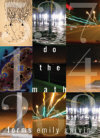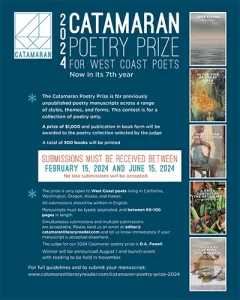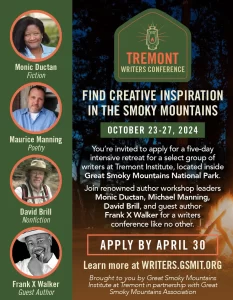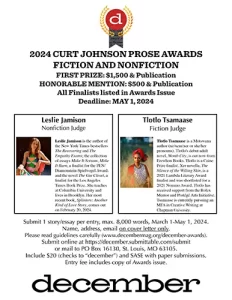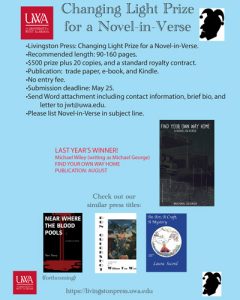Do the Math
Emily Galvin likes details. In her mini-plays that make up the first half of the book, she pencils every texture, breath, and tilt of head with conspicuous meticulousness, as if the rabid observation of minutiae should yield meaning like the sudden breakthrough in a mathematical proof. This approach often leads to pieces that are more description than dialogue, but with focus that renders it powerful, rather than an inanely panning camera eye. The terse dialogues that do ensue have an amplified gravity, and given their binary form, cannot fail to call up Endgame or another of Beckett’s masterpieces.
Emily Galvin likes details. In her mini-plays that make up the first half of the book, she pencils every texture, breath, and tilt of head with conspicuous meticulousness, as if the rabid observation of minutiae should yield meaning like the sudden breakthrough in a mathematical proof. This approach often leads to pieces that are more description than dialogue, but with focus that renders it powerful, rather than an inanely panning camera eye. The terse dialogues that do ensue have an amplified gravity, and given their binary form, cannot fail to call up Endgame or another of Beckett’s masterpieces.
With the increasing impact of science and technology, it is no surprise that many writers are turning to these to find new metaphors and structures for their work. With Wikipedia, it has become even easier to find easily digestible bases for our fiction and poetry. Unfortunately, Emily Galvin’s use of mathematical ideas in her forms and writing is immediately seen as a gimmick to anyone who happens to know enough about math to understand the implications of the structures. There is even a four-page introduction by a mathematician that doesn’t really explain the math used by Galvin and the relevance to the themes; it just blithely acknowledges the presence of math in poetry.
Galvin makes much use of the Fibonacci sequence, which characterizes natural growth, spirals, and most famously, the Golden Ratio, yet there is no sense of these issues in her poems aside from syllable counting. She also calls on Euclid’s algorithm for finding the greatest common divisor of two numbers. However, almost all her poems use numbers that are relatively prime, which renders the algorithm meaningless beyond the trite observation that they have nothing (or one thing) in common. The beautiful lattice of relations in mathematical spaces has been negated, not used. She may just be using these ideas as a novel framework, but form without intent renders the form irrelevant. The simple idea of facing a brutal reality, characterized by the phrase “do the math,” may be the main thrust, but using complex structures to do this seems misguided.
Not that these poems are bad. In fact, the first section is quite captivating, and she demonstrates a good ear, using short, repetitive phrasing to highlight the drama of the moment:
In the room, the light is slanting and yellow. This is winter afternoon light, the light that hits an Iowa cornfield at about 3:00 pm on a sunny day in February. Very deep slant, very warm yellow. It is hitting the aspens in pieces.
If there could be a little wind, that would be nice.
Galvin’s poems excel in rendering distance by close focus, zooming in on lips searching for words that never come. In her mini-dramas, we see the spiral of unknown motivations lost forever in the characters, repeated actions as futile as counting to infinity. Consider the scene after a couple has an inexplicable fight over the woman looking for her hair clip:
BEN waits until there are creaks overhead. He turns, looks at the armchair. He sits. He stares out in front of him. Then, without moving his eyes from the point in space on which they’ve been fixed, slowly brings his left hand to his right breast pocket. He pulls out a small, purple, rhinestone hair clip, shaped like a dragonfly. He brings his hand, dragonfly in it, to his lap. He lays his left hand on his open right hand. He looks down at his hands, at the hair clip. Twenty seconds goes by in this position.
BEN (Without moving anything but his mouth, calling upstairs) I can’t find it!
The book finishes with Galvin’s lyrics, which are generally less interesting. She is again at her best when most stark, most evocative, probing the internal rather than drawing on external phenomena, with one notable exception: “Sometimes, if things get really hot, the stars turn iron into gold, and then, and then just to make the alchemists weep, gold into lead.” The book, in fact, feels the same way: pressure brings out her best at the beginning, and then the loss of focus that arises from sustained forcing devolves into the end pieces.
All in all, Do the Math showcases an artist with wide potential. Dramatist, poet, polymath, it’s only a matter a time before Emily Galvin crystallizes a true winner from the chaos of her myriad of interests.

